A home is not just a building that must be maintained, it's an environment—a complex of living space and conditions in which you and your family spend a major part of your lives. This section focuses on some of the most important things you can do to make sure it's a safe and healthy environment.
EVALUATING HOME SAFETY
Most accidents happen at home, primarily because that is where people spend most of their time. Even a modest effort in making your home safer can greatly reduce the chances of a serious or even fatal accident.
To evaluate the present situation in your home, first identify the places where accidents are most likely to occur—the bathroom, stairs, and unlighted areas, for example—and the kinds of hazards that exist. Loose carpeting, in adequate railings, dark stairways, and unprotected electrical outlets are common hazards.
Next, make a list of what needs to be done and get to work. You can’t do everything at once, so give priority to those things that put young, elderly, or handicapped family members at special risk.
COMMON SAFETY HAZARDS
Protection against fire, perhaps the most devastating accident in a home, is covered in Section 36. Installing ground fault interrupter (GFI) protection to reduce the danger of electrocution or severe shock is covered elsewhere in this guide. Supplement GFI protection by re placing metal wall plates on switches in sink and other damp-work areas with plastic plates and mounting screws. To prevent toddlers from sticking things in to electrical outlets, put plain plastic inserts in unused receptacles and use ex tension cords with safety caps.
While the hazards of fire and electricity usually come to mind first, the most common home accidents involve falls and serious bumps, burns and scalds, and accidental poisoning.
FALLS and BUMPS
Be sure carpeting is secure. Fasten stair runners at the rear of each tread. Put nonslip mats under throw rugs on polished floors and under the bathmat in a tiled bathroom. If your tub or shower does not have a matte-surface floor, add adhesive nonslip strips or a rubber mat with suction cups on the underside. Install full-depth nonslip material on the treads of basement and attic stairs.
Provide true grab bars—not just tow el bars—in the shower or tub, and per haps beside the toilet for an elderly per son. Provide handrails on all stairs. The elderly often need rails on both sides, and sometimes along hallways as well. Children need a rail at a proper height for their size; it can be removed when they grow. Mount all grab bars and railings with screws long enough to reach into wall studs.
Make sure that halls and stairways have adequate light at all times. An easy solution is to use small lights that plug directly into a receptacle. They come on automatically at night or during the day whenever the ambient light drops below a certain level, and they consume only a quarter-watt of power or less.
Wherever things are stored on over head shelves, provide a sturdy step stool or short stepladder with a built-in hand bar at waist height. Group items on high shelves in boxes or plastic baskets to prevent them from falling.
Round off sharp corners on counters tables, and fixtures, or cover them with stick-on rubber or plastic bumpers. A corner at hip height for an adult is at eye or throat height for many children.
Outdoors, proper step, porch, and deck railings are essential (see Section 30). A ground-level swimming pool must be enclosed by its own 4-foot-high fence with a locking gate. This is the law in most places, and a liability requirement in home insurance policies.
Cover basement window wells with gratings or plastic domes so a child can not fall in. Cover outdoor basement steps with a door or doors at surface level. Make sure it can be securely fastened both closed and open. If your garage door has an electric opener, adjust the safety stop/reverse sensitivity carefully to make sure that a child can't be trapped under it.
Install swings and play equipment over earth, sand, or other soft material. Make sure they are securely fastened against tipping over. Keep trees well pruned, so that when youngsters climb they have solid limbs to hang onto.
BURNS and SCALDS
In the kitchen, keep pot handles turned out of the reach of children and where they can't be bumped accidentally, Equip drop-in ranges and pull-out cook- tops with anti-tipover brackets. Some models have them; older models can be retrofitted easily. Many microwave and wall ovens have double-latching doors to childproof them. Accessory latches are available for older models.
Glass-paneled tub/shower enclosures must have shatter-resistant safety glass. You can have existing sliding panels re-glazed, or get new replacements.
Modem building codes require the use of tub shower valves with antiscald protection. One kind has a high-limit stop that restricts movement so a certain amount of cold water is always mixed with the hot, to keep it at a safe temperature. However, that does not protect against a sudden pressure drop if some one flushes a toilet. A pressure-balancing valve does maintain a certain temperature even when the pressure in either the hot or cold water line varies, but it does not respond to temperature changes in the lines. Only a true temperature-control mixing valve will mix the proper amounts of hot and cold water to maintain a con- stunt temperature. If you don't want to change mixers, you can replace the shower head with one that contains a heat-sensitive alloy. When the water temperature exceeds 120°F, the alloy expands and immediately cuts off the flow.
POISONING
Poisonous substances in the home must be clearly marked for adults, and made inaccessible to children. Locking cabinets are suitable in the basement, workshop, or garage, but impractical in the bathroom, kitchen, and laundry. In those locations, one solution is a latch that interlocks adjacent cupboard door handles. Another is a double-acting latch that opens the door only an inch or two when first tripped and requires a second action to open fully. A third is a latch with no handle on the outside of the door. it's activated by an accessory mag net that is kept nearby, out of the reach of a child. These and similar devices are available at home centers, houseware stores, and kitchen and bath suppliers.
Home Safety Improvements
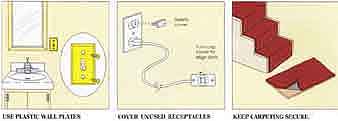
USE PLASTIC WALL PLATES and plastic mounting screws on switches
in bathrooms and kitchen wet areas. GFI protection may cover only the receptacles
there.
COVER UNUSED RECEPTACLES with plug-in plastic covers, and use extension cords with safety caps, to prevent children from sticking things into the slots.
KEEP CARPETING SECURE. Fasten stair runners at the back of each tread. Place thin nonslip mats under throw rugs on polished or tile floors.
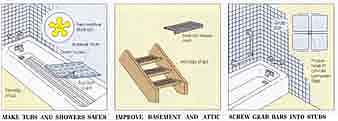
MAKE TUBS and SHOWERS SAFER with stick-on strips or decorative
cutouts of nonslip material, or a waterproof mat with suction cups on the
underside.
IMPROVE BASEMENT and ATFIC STAIRS with nonslip adhesive strips, or rubber mats nailed to the treads. Or use paint containing nonslip abrasive particles.
SCREW GRAB BARS INTO STUDS in tubs, showers, and elsewhere. To probe for a stud, drill a small hole between tiles; it can be filled easily.
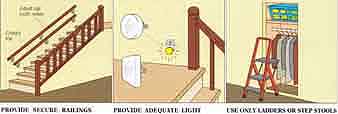
PROVIDE SECURE RAILINGS on all stairs, indoors and out. Double
railings are helpful to the elderly or handicapped; children need a rail at
their own height.
PROVIDE ADEQUATE LIGHT in halls and on stairs at all times. Small plug-in lights come on automatically when needed and consume almost no power.
USE ONLY LADDERS OR STEP STOOLS with safety bars to reach high shelves. Store items in plastic baskets or boxes so they can't spill down on you.
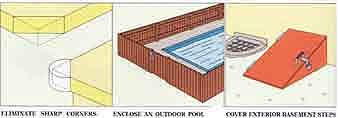
ELIMINATE SHARP CORNERS. Cut them off at an angle, or round
them with a sander where feasible. In other cases, cover them with adhesive-backed
bumpers.
ENCLOSE AN OUTDOOR POOL with a fence (rails on the inside) and locking gate. Post safety signs. Install a ground fault interrupter on the pool pump.
COVER EXTERIOR BASEMENT STEPS with a door that can be locked shut and fastened safely open. Cover window wells with grates or plastic domes to keep toddlers out.
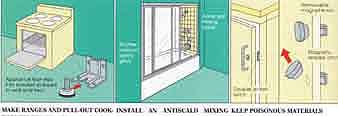
MAKE RANGES and PULL-OUT COOKTOPS TIP-PROOF with security
brackets. If not included with your unit, brackets are available from appliance
dealers.
INSTALL AN ANTI-SCALD MIXING
VALVE or showerhead in the bathroom. Be sure panels or doors are glazed with shatter- resistant safety glass.
KEEP POISONOUS MATERIALS in cabinets with childproof latches. Even ordinarily safe substances are dangerous to a child who drinks them or gets them in the eyes.
CHILD SAFETY
It’s virtually impossible for any parent to exercise constant vigilance over their children for the entire day. During brief interruptions of supervision, children can wander into lethal situations. The best way to insulate children from the hazards of the home is to childproof the home environment. Childproofing a home is a way of adding special safe guards throughout the home environment—safeguards that protect the child without inhibiting his/her ability to explore and learn. This also includes buying and using products that are rated with a stamp of approval from an accredited organization, such as the Juvenile Products Manufacturers Association or Consumer Reports. Their approval means that those products meet the safety standards set by a panel of experts.
Childproofing the home begins with an inspection of the entire home, or rather those areas where the child is apt to roam. Rather than simply walking about the house, conduct the inspection on your hands and knees and look for potential hazards. This will help you to see the home environment from a child’s point of view.
OUTLETS and APPLIANCES
Electrical outlets and appliances are especially dangerous because curious children often experiment by poking metal objects into outlets. It’s easy to safeguard the outlets with outlet plugs. These are nonconductive plastic inserts (available at hardware stores and home centers) that fit into and block the outlet holes. For receptacles that are often needed for an appliance, you can mount spring safety caps that cover the plug and outlet yet snap back when the receptacle is needed.
Children like to chew on and yank appliance cords so these pose a danger to the curious toddler. Never allow an appliance cord to dangle where a child can pull on it. Make cords as short as possible with telephone cord shorteners or coil them and tie the coil with twist ties. If this is not possible, tape the cord out of the reach of the infant. Be sure to unplug all appliances that are not being used so they can not be turned on.
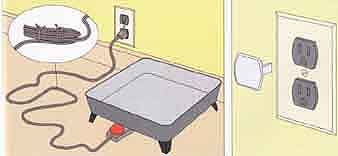
USE TWIST TIES TO TAKE UP THE SLACK in an appliance cord and keep the cord as short as possible. Remember to unplug the appliance when
it’s not in use to prevent children from accidentally turning it on. PLACE
PLASTIC PLUGS in all unused outlets. These will prevent children from inserting
small objects into the outlet holes.
LOCKS and DOORS
Lock all doors that you don’t want your children to open. This is especially true of doors to a stairway entrance. it's not necessary to install a key lock; a hook and eye or locking catch located high on the outside of these doors will suffice. Doorknob covers, loose-fitting attachments that make it difficult for a child to grip and turn the knob (you can also use a loose sock for this), are another way to safeguard a door.
Some doors, such as closet doors, should not lock because a child could easily get trapped inside. Tie a dish towel from knob to knob to keep the door from locking. This will also pre vent the door from closing completely and pinching a child’s hands.
The bathroom door should have a special lock so adults can lock it, yet parents must be able to open it from the outside if a young child accidentally locks himself in. Such locks are avail able; they have a push button on the in side knob and a small hole in the center of the outside knob. They can be locked from the inside by pushing the button and unlocked from the outside, if necessary, by pushing a length of stiff wire through the hole. Hang a piece of wire on a hook outside the door so you have it ready in case of an emergency.
WINDOWS
Windows are dangerous for a number of reasons. Obviously a child can easily fall through an open window. Install safety latches on double-hung windows to prevent the bottom sash from opening more than a few inches. If you need more air, open the tip sash. For additional protection, install window guards across the bottom of window openings (many city codes require these in windows above the first floor).
Even a closed window or a closed sliding glass door can be dangerous be cause the clear glass looks like an opening that anyone could walk or run through. Alert children to the presence of a closed glass door or window by mounting decals or strips of colorful tape on the glass panes. To provide an extra measure of safety, install safety- tempered glass in all large windows and glass doors.
Window treatments, such as blinds or curtains, often involve dangling cords that can pose a danger to children. Be sure to keep these cords tightly coiled and tuck them away far out of the reach of children. Be sure to place cribs far enough away from these dangling cords so a child can not reach the cord and strangle himself.
KITCHENS AM) BATHROOMS
Kitchens and bathrooms are the most dangerous rooms for children. To pre vent children from touching the stove burners, install a stove guard (essentially a small fence) around the burners. When cooking, turn the handles on pots and pans in toward the stove, so a child can not knock them down and burn himself. Remove the burner knobs when you’re not using the stove so they can't accidentally be turned on.
Install appliance latches on all major appliances like the oven, refrigerator, microwave, dishwasher, and trash compactor. Keep countertops as clutter-free as possible. Place safety latches on kitchen cabinet doors and drawers. Be sure to keep all poisonous cleaning sup plies in a securely locked cabinet out of the reach of children.
In the bathroom, dangerous burns can come from the hot water faucets. Reset your hot water thermostat to 120°F. This will keep the water temperature warm enough for bathing, but not scalding hot.
The toilet bowl may not seem dangerous at first glance, but it’s not difficult for a curious child to fall into the bowl and drown. This danger can be eliminated by installing a lid lock. Whether in the kitchen, bathroom, or other area of the house, never leave an accumulation of standing water unattended.
Another possible danger in the bath room is in the medicine cabinet. All medicines should be enclosed in child- proof containers. and , as an extra safe guard, install a safety lock on the medicine cabinet.
While it’s impossible to make your house 100 % danger-free, if you take the safety precautions described here and use your best judgment, you’ll be rest assured knowing that your home is a child-safe environment.
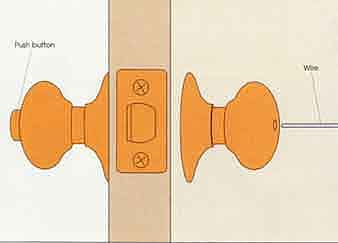
INSTALL A PUSH-BUTTON LOCK ON THE BATHROOM DOOR to ensure
no one gets locked inside. This lock should have a hole in the knob to make
it easy to open from outside the room.
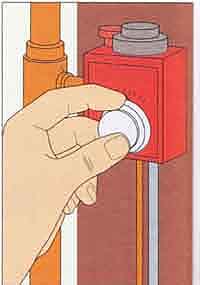
LOWER THE THERMOSTAT on the hot water heater to 120°F. This
will keep tap water from getting scalding hot.
HOME HEALTH
Conscientious household cleaning at regular intervals prevents major accumulations of dust and surface dirt and con tributes a great deal to maintaining a healthy living environment. But even a well-cleaned home can have an interior atmosphere that contains health hazards. Except in cases of extreme contamination, a homeowner should not be frightened that his or her house is a potential disaster area, but it's good to understand what the problems can be, and what can and should be done about them.
Many houses are built of materials that were once considered quite safe, but are now known to emit harmful gases, or to deteriorate into unhealthy dust and particles. Many synthetic products emit gases that, when allowed to collect, are harmful. The hazard of radon gas entering the house from the surrounding soil has been recognized only relatively recently.
Old, poorly insulated houses with joints opened due to shrinkage of building materials and loose-fitting windows and doors may admit biological pollutants from outside rather freely. But, surprisingly, biological problems stemming from mildew, mold, and concentrations of allergenic substances are often more of a problem in new, well-insulated and tightly sealed houses. The problem is that the interior air is effectively trapped, which may perpetuate conditions that permit the growth of bacteria or the leaking of gases. When these conditions occur in a central heating/air-conditioning system, a humidifier, or other air-circulation equipment, the entire house can be contaminated in a matter of minutes.
How dangerous are these hazards? Some conditions will just give you a headache or make you sneeze. But others, if allowed to exist unchecked over a period of time, can cause serious illness or even be fatal.
To maintain a healthy home environment, you first need to know whether hazardous materials are present. Before you repair or remodel, test for the presence of lead, asbestos, chlordane, car bon monoxide, and radon. You can purchase inexpensive do-it-yourself test kits for many of these substances at home centers or through mail-order catalogs. For example, to find out if lethal carbon monoxide (CO) gas is leaking into your basement from your furnace or gas hot water heater, hang a matchbook-sized CO indicator nearby. Its color will change from orange to brown if ex posed to a dangerous concentration of the gas. You also can check with your local health department for the names of certified services that will do the various tests for you.
Next, determine the best strategy to eliminate or reduce any health hazard that may exist. Federal agencies such as the Environmental Protection Agency (EPA), Occupational Safety and Health Agency (OSHA), and the Department of Housing and Urban Development (HUD) have strict guidelines for dealing with lead, asbestos, radon, and chlordane. These include safe exposure levels, handling requirements, and corrective remedies. To get this kind of information, check with your local health department and EPA office. Many communities are now mounting aggressive anti-lead pro grams. Specialized protective gear, equipment, and training are required to address some hazards safely, so you may need to hire certified contractors to per form the work.
Also survey your home for likely sources of biological pollutants that could cause allergic, toxic, or infectious reactions. Whatever conditions you find, a thorough cleaning should be your first line of health defense, followed by the measures discussed in next section.
Use the list below to help you identify and evaluate common potential health hazards in your home.
COMMON HOME HEALTH HAZARDS
CONTAMINANT / POLLUTANT |
POSSIBLE SOURCE |
Lead |
Chalking exterior paint leaching into soil Chalking interior paint dusting into air Moisture-damaged interior paint flaking onto floor Paint on surfaces chewed on by infants, toddlers Lead water-service pipe to house Lead solder in pipe fittings Brass and chrome-plated brass faucets Vehicle emissions |
Asbestos fibers |
Pipe and furnace insulation Resilient flooring, backing, adhesive Textured paint Old drywall taping compound Acoustical tiles Cement asbestos shingles, siding |
Mold, bacteria |
Dirty heating/ventilating/air-conditioning filter Dirty humidifier filter, water tank Dirty refrigerator drip pan Poorly ventilated high-moisture areas Dirty, moist ducts |
Gases |
Unventilated crawl space (radon) Leaky furnace flue (carbon monoxide) Open sump for basement pump (radon) Volatile pesticides, termiticides |
Various water contaminants |
Toilet, hose outlet, or furnace boiler without backflow protection Blocked or improperly vented drain/waste/vent lines Seepage into well from leaking septic tank or overworked leach field |
DEALING WITH HEALTH HAZARDS
The most common home health hazards are lead, asbestos, and various biological pollutants. Although now banned from most building materials, lead and asbestos are still present in millions of homes. Biological pollutants may come from outside, or arise in hidden conditions within the home.
If you suspect you are living with these hazards, test to determine whether there is any actual contamination. Your health department or local EPA office can recommend test procedures and labs. For example, use a do-it-yourself kit to test for lead in samples of tap water that has stood in the pipes overnight, or send samples to a lab. To test for hazards from lead paint or asbestos, pass baby wipes over window sills, floors, and furniture, seal them in plastic bags, and send them to a lab for analysis. You can also test samples of mold, mildew, and dust, or have them analyzed by a lab. If there is contamination, there are several things you can do to re duce or eliminate the danger it presents.
LEAD
Lead can occur in water used for drinking or cooking, and in the fumes of various substances as they melt or burn. Once in the body, lead is not excreted; it accumulates. Over time, it can cause mental retardation, brain lesions, and chronic liver and kidney disease. Children and pregnant women are especially at risk.
Where does the lead come from? Old water service lines into homes in some cities are lead pipes. Until 1986 lead was a primary ingredient in solder used to join copper plumbing fittings. The brass alloys used in faucets also contain lead. and lead pigments were widely used in oil-based paints before 1978.
If there is lead in your water, reduce your exposure by letting the water run for 30—90 seconds before using it for drinking, cooking, or bathing, and al ways start with cold water for cooking. The only real solution is to install new fit tings using lead-free materials. This can be expensive, but the work itself does not create additional exposure hazards.
LEAD PAINT
Often, the easiest way to deal with lead- painted interior walls is to cover them with a layer of drywall, thin paneling, or tile board. If deteriorating lead paint is a problem outside, the entire house can be covered with vinyl or aluminum siding without disturbing the old surface. It usually is better to replace lead-contaminated moldings and trim with new pieces, but with doors or jambs you may want to remove the paint itself.
Removing lead paint can create a serious health hazard if done improperly. Dry-scraping, sanding, and sandblasting are the worst techniques, because the create fine dust that spreads widely ar is difficult to clean up. Softening paint with heat and scraping it off causes les dust, but can create lead fumes if the paint gets too hot. To control the temperature better and lessen the risk o fire, use an electric heat gun rather than an open-flame torch. Maintain plenty of cross-ventilation and wear a tight-fitting organic-filter respirator, not merely a disposable dust mask.
Liquid and paste chemical strippers don't produce lead fumes, but may give off other harmful fumes. Some are highly flammable or caustic, or contain suspected carcinogens. and some leave a fine surface film that may contain lead.
PAINT REMOVAL
Disturbing a lead-painted surface is not a casual undertaking. If you decide to do it yourself rather than hire a certified professional, here are some safeguards you should follow.
If possible, take objects outdoors for stripping. When surfaces must be stripped in place, move furniture out of the room. Cover the floor with plastic and seal the door with plastic and tape If limited scraping or sanding is unavoidable, first dampen the surface with water from a spray bottle to control air borne dust. Clean up chips and dust with a rented HEPA (high-efficiency particulate air) vacuum, wet mops, and sponges. A wet-dry shop vacuum or an ordinary household vacuum will merely spread the lead-contaminated dust.
Wear protective coveralls, gloves, head and eye protection, and a respirator certified by NIOSH (National Institute for Occupational Safety and Health). If possible, exit through a window or exterior door and change clothes in the garage or elsewhere, to avoid spreading lead dust through the rest of the house. Keep family members—and pets—out of the work area until dust tests confirm that it's not contaminated.
ASBESTOS
The primary danger from asbestos is airborne fibers. When breathed into the body, the fibers lodge in the lining of the lungs, where they can cause disease or cancer that may not appear for many years. Fibers are released into the air when asbestos insulation is disturbed, and when asbestos-containing materials are sanded, sawed, broken, or shredded.
Houses built between 1930 and 1950 may contain asbestos insulation, especially around steam and hot water pipes, and furnaces. Textured paint and patching compounds used before 1977 often contained asbestos. and pre-1977 resilient tiles and sheet flooring often had asbestos fibers in their backings.
Dangerous asbestos insulation should be removed, or encapsulated to prevent fibers from escaping. don't attempt this kind of work yourself. Specialized contractors are trained and certified for such projects and have the necessary equipment and materials. However, you can safely remove resilient sheet flooring that contains asbestos fibers, using the following procedure prescribed by the Resilient Floor Covering Institute.
REMOVING RESILIENT FLOORING
You will need a helper. You both should wear gloves, goggles, and dust masks. Cut the material into long 6-inch-wide strips using a utility or flooring knife and a straightedge. Then begin to pry up the first strip, using a flooring chisel. As the flooring separates from the adhesive, wet the back thoroughly with a spray bottle to minimize airborne fibers. Roll the strip into a tight coil as you go. Tie coils securely and seal them in plastic bags. Check with your local health or sanitation department to find out how to dispose of the bagged material.
BIOLOGICAL POLLUTANTS
Biological pollutants need moisture and nutrients to survive. The average home has an abundance of both, but you usually can avoid serious problems by con trolling moisture and cleaning properly.
Moisture provides a breeding spot for mold, mildew, and bacteria. Its sources include damp ground in a crawl space, seepage through basement walls or faulty roof flashing, and condensation from a steamy shower or even water boiling on the stove. To help keep your home healthy, use the measures given in the box at the right.
CLEANING
The systems that move or condition the air in a home are very vulnerable to contamination from biological pollutants. They also will spread the contaminants.
Clean humidifier tanks, refrigerator drip pans, and air purifiers and change their filters on a regular basis. Do the same with air conditioning and forced- air heating/ventilating systems. Follow the manufacturer’s directions. Some times biocides are recommended to retard the growth of bacteria; otherwise a mild solution of chlorine bleach in water will kill mold spores and discourage their return. However, dead mold spores are just as allergenic as live ones. Unless you actually remove all of the mold from a surface, you may still have a problem. Effective methods for cleaning forced-air systems are explained in Section 35.
Ultraviolet (UV) rays are the most effective way to eliminate mildew. Bathe contaminated areas with light from an incandescent UV lamp for several hours. Then brush and vacuum away all visible deposits and treat the surface with a mildewcide.
DUST MITES
Any organic material can provide nutrients for biological pollutants. But microscopic dust mites are partial to the dead skin scales people slough off by the mil lions each day. When carpeting, bedding, or upholstered furniture become infested with dust mites, their excrement can be highly allergenic, especially to people with asthma or respiratory difficulties.
To discourage dust mites, wash bed ding weekly in hot (140°F) water; cooler water will not kill them. Shampoo carpeting once a year, perhaps with rental power equipment. Use a vacuum for mu- tine cleaning at other times. If allergies or respiratory disorders are a problem in your home, pre-treat the carpet with a commercial product that kills the mites and makes it easier to vacuum up allergenic waste. Work slowly and change the bag regularly; some dust inevitably gets into the exhaust as a vacuum bag fills.
REMOVING RESILIENT FLOORING

SLICE FLOORING INTO LONG STRIPS about 6 inches wide. Wear gloves,
goggles, and a dust mask. PRY UP and ROLL one strip at a time, wetting the
back to hold down fibers. You’ll need a helper, protectively clothed. TIE
EACH ROLL securely; seal tied rolls plastic bags. Check with local authorities
regarding proper disposal.
CONTROLLING MOISTURE FOR HEALTH:
• Equip each bathroom with an exhaust tan, even if there is a window. In cold areas, people seldom open a window in the middle of winter.
• Vent a clothes dryer to the outdoors. Letting it exhaust indoors may conserve heat in the winter, but it adds moisture to the air.
• Block rising moisture from crawl spaces with plastic sheeting, especially if air ducts pass through the space.
• Wrap the joints of air ducts passing through any unheated areas with duct tape, to prevent moisture penetration.
• Properly install vapor-retarding barriers and insulation between heated / cooled spaces and unconditioned spaces, to pre vent condensation.
• Install weather stripping around the door or hatch to an unheated attic Caulk around fixtures on the ceiling below the attic.
• Repair faulty flashing, roofing, or gutters that are creating moisture problems indoors.
Use dehumidifiers and air conditioners to reduce airborne moisture in humid weather, but be sure the appliances don't themselves become sources of pollution.
• Put down plastic sheeting as a physical barrier and underlayment as a thermal break before laying carpeting over a concrete slab. This will prevent moisture that wicks up through the slab from condensing on the carpet backing.
Previous: Fire Prevention and Protection in the Home Next: Security